#lifecycle modeling
Explore tagged Tumblr posts
Text
How an Estimating Service Powers Lifecycle Cost Planning for Long-Term Assets
Introduction For projects like hospitals, universities, or public infrastructure, initial construction is just one piece of the financial puzzle. Long-term operational costs often eclipse build costs. An estimating service helps clients plan for the entire lifecycle of an asset, from cradle to reinvestment.
Beyond Initial Construction Estimators traditionally focus on upfront costs, but lifecycle planning expands that role. Estimating services now project long-term expenses such as maintenance, utilities, staffing, and system replacements, giving a holistic view of asset ownership.
Durability and Material Forecasting Material choice directly influences lifecycle costs. Estimators compare the upfront cost of high-durability components versus cheaper alternatives, factoring in maintenance frequency, replacement cycles, and overall longevity.
Energy Performance Projections Energy efficiency affects long-term budgets. Estimating services integrate performance modeling into their forecasts, calculating how HVAC choices, insulation levels, and lighting systems will influence utility costs over decades.
Maintenance and Downtime Consideration Hospitals or data centers can’t afford frequent shutdowns. Estimators quantify the cost of scheduled maintenance and potential downtime, guiding decisions toward systems that balance performance with reliability.
Technology Obsolescence and Reinvestment Timing In high-tech buildings, estimating services help predict when technology will become outdated and budget for its eventual upgrade. This ensures financial plans account not only for installation but future modernization.
Supporting Asset Management Planning Lifecycle cost estimates become tools for facility managers and CFOs. Estimating services provide detailed documents that align capital investment with long-term operating budgets and help in scheduling reinvestment cycles.
Conclusion An estimating service isn’t just about today’s cost. It supports intelligent long-term asset planning by forecasting the financial implications of design and system choices, giving stakeholders a full lifecycle view.
#estimating service#lifecycle cost#long-term assets#construction budgeting#facility planning#asset management#building lifecycle#energy forecasting#cost modeling#durability analysis#maintenance budgeting#system replacement#long-term planning#total cost ownership#material longevity#reinvestment planning#capital expenditure#asset forecasting#lifecycle modeling#energy savings#HVAC lifecycle#system cost#long-term savings#predictive estimating#estimating documentation#smart investment#sustainability budgeting#tech upgrade cost#operational cost#building efficiency
0 notes
Text
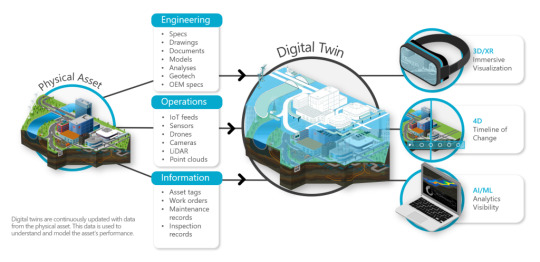
Digital Twin technology combines physics-based simulation, real-time data, machine learning and AI to create a dynamic virtual replica which is scalable from a single building to an entire campus, city or portfolio.
Responding and behaving like its real-world counterpart to provide detailed insights across a range of building performance metrics and empowering informed decisions on how to reduce energy, lower costs and work towards net-zero goals.
Optimise Building & System Operation
Develop long term Net-Zero Investment Plans
Minimise costs of Decarbonisation
Monitor progress towards Net-Zero Goals
As buildings are complex, dynamic systems that constantly change throughout their lifetimes. Digital Twin for building lifecycle understands this and integrates, from initial design or retrofit, through commissioning and ongoing operation, to ensure your building(s) stay on track towards zero-carbon goals.
#Digital Twin#Building Lifecycle#Machine Learning#Artificial Intelligence#Net Zero Building#As built Model
0 notes
Text
Green energy is in its heyday.
Renewable energy sources now account for 22% of the nation’s electricity, and solar has skyrocketed eight times over in the last decade. This spring in California, wind, water, and solar power energy sources exceeded expectations, accounting for an average of 61.5 percent of the state's electricity demand across 52 days.
But green energy has a lithium problem. Lithium batteries control more than 90% of the global grid battery storage market.
That’s not just cell phones, laptops, electric toothbrushes, and tools. Scooters, e-bikes, hybrids, and electric vehicles all rely on rechargeable lithium batteries to get going.
Fortunately, this past week, Natron Energy launched its first-ever commercial-scale production of sodium-ion batteries in the U.S.
“Sodium-ion batteries offer a unique alternative to lithium-ion, with higher power, faster recharge, longer lifecycle and a completely safe and stable chemistry,” said Colin Wessells — Natron Founder and Co-CEO — at the kick-off event in Michigan.
The new sodium-ion batteries charge and discharge at rates 10 times faster than lithium-ion, with an estimated lifespan of 50,000 cycles.
Wessells said that using sodium as a primary mineral alternative eliminates industry-wide issues of worker negligence, geopolitical disruption, and the “questionable environmental impacts” inextricably linked to lithium mining.
“The electrification of our economy is dependent on the development and production of new, innovative energy storage solutions,” Wessells said.
Why are sodium batteries a better alternative to lithium?
The birth and death cycle of lithium is shadowed in environmental destruction. The process of extracting lithium pollutes the water, air, and soil, and when it’s eventually discarded, the flammable batteries are prone to bursting into flames and burning out in landfills.
There’s also a human cost. Lithium-ion materials like cobalt and nickel are not only harder to source and procure, but their supply chains are also overwhelmingly attributed to hazardous working conditions and child labor law violations.
Sodium, on the other hand, is estimated to be 1,000 times more abundant in the earth’s crust than lithium.
“Unlike lithium, sodium can be produced from an abundant material: salt,” engineer Casey Crownhart wrote in the MIT Technology Review. “Because the raw ingredients are cheap and widely available, there’s potential for sodium-ion batteries to be significantly less expensive than their lithium-ion counterparts if more companies start making more of them.”
What will these batteries be used for?
Right now, Natron has its focus set on AI models and data storage centers, which consume hefty amounts of energy. In 2023, the MIT Technology Review reported that one AI model can emit more than 626,00 pounds of carbon dioxide equivalent.
“We expect our battery solutions will be used to power the explosive growth in data centers used for Artificial Intelligence,” said Wendell Brooks, co-CEO of Natron.
“With the start of commercial-scale production here in Michigan, we are well-positioned to capitalize on the growing demand for efficient, safe, and reliable battery energy storage.”
The fast-charging energy alternative also has limitless potential on a consumer level, and Natron is eying telecommunications and EV fast-charging once it begins servicing AI data storage centers in June.
On a larger scale, sodium-ion batteries could radically change the manufacturing and production sectors — from housing energy to lower electricity costs in warehouses, to charging backup stations and powering electric vehicles, trucks, forklifts, and so on.
“I founded Natron because we saw climate change as the defining problem of our time,” Wessells said. “We believe batteries have a role to play.”
-via GoodGoodGood, May 3, 2024
--
Note: I wanted to make sure this was legit (scientifically and in general), and I'm happy to report that it really is! x, x, x, x
#batteries#lithium#lithium ion batteries#lithium battery#sodium#clean energy#energy storage#electrochemistry#lithium mining#pollution#human rights#displacement#forced labor#child labor#mining#good news#hope
3K notes
·
View notes
Text
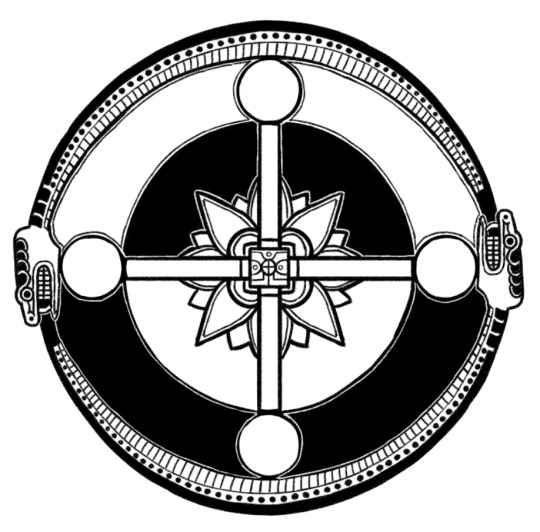
The earth wheel.
This is a Wardi symbolic motif that represents God and the world in totality, and embodies the philosophy of life at large being sustained by perpetual cycles of death and birth, from human and animal life, to the world's seasons, to the sun and moons.
The wheel can be simplified into a basic design of a circle with a cross through it, though this more elaborate form has emerged and become prominent as a confluence of different symbols, and depicts a near-complete cosmological worldview. The full wheel has an outer and inner circle, four suns along the spokes, a lotus at the center, and two connected serpents surrounding it.
The earth wheel is most succinctly a model of the cycles of human life and the seasons, which are reckoned as following the same basic patterns. To this end, it is partially an abstract representation of the solar calendar, which is divided up into two great seasons and subdivided into four suns (months are divided separately as twelve 30-day months and one 5-day intercalary month, and not represented in this symbol).
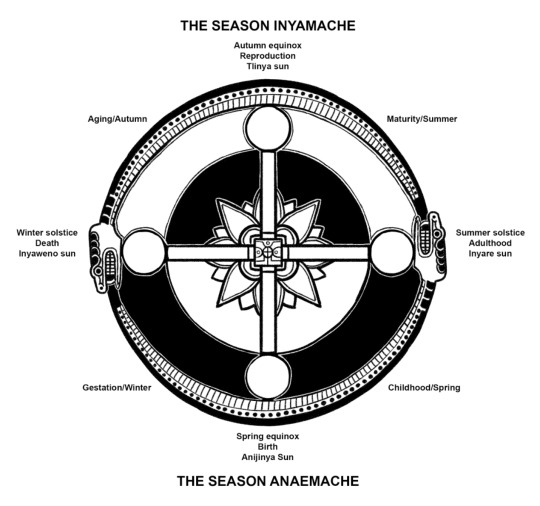
The season Anaemache starts after the winter solstice on the solar calendar. It is divided into two suns, Inyaweno (the newborn sun after the winter solstice) and Anijinya (the ripening sun after the spring equinox), and Roughly contains the winter and spring seasons. It is the time in which most crops are planted and most rain falls, when most livestock and wild animals give birth, when the earth sees renewal and peak growth, the sun is reborn and the days grow long. On the wheel, it is represented by the dark half of the outer circle, with the color black being partly associated with purity of water, fertile potential, good soil, and feminine qualities.
This season is considered analogous to gestation, birth, childhood, and the cusp of adulthood in the human lifecycle, when the body is young and strong and reaching its prime.
The season Inyamache starts after the summer solstice on the solar calendar. It is divided into two suns, Inyare (the mature, waning sun after the summer solstice) and Tlinya (the dying sun after the autumn equinox), and Roughly contains the summer and autumn seasons. It is the time where most crops are harvested, when most livestock and wild animals breed, little rain falls and plants begin to wither, the days grow shorter and the sun finally dies. On the wheel, it is represented by the light half, with the color white being associated with purity of light, transformation, sunlight, and masculine qualities.
This season is considered analogous to adulthood, procreation, aging, and death in the human life cycle, when a person's purpose shifts to tending the next generation and their body passes out of its prime and nears its end.
This solar calendar-based wheel does not intend to measure the material conditions of the seasons with great accuracy (Inyamache conditions take up more of the year than Anaemache, for one thing), but rather to represent and unify the changes of the sun, earth, and human life under the same philosophical model.
The internal structure of the wheel symbolizes the earth itself and life within. The darkened half in this portion is representative of death and night, the lightened half is birth and day. A lotus motif fills the center, indicative of life itself being perpetually sustained by these cycles, and a representation of God's dead physical body being renewed into a living earth. Lotuses are very central symbols of birth, fertility, and seasonal renewal, and most variants of the creation story describe both God and the first people either emerging Like or As lotuses (the mythical first man Hounyari's name is a compounded 'first of the lotuses').
The spokes represent four great transitional periods of human life, being one's birth, coming of age, procreation, and death. All of these transitions support the movement of the greater wheel and are necessary for the perpetuation of life and of one's people. The spokes also represent the solstices and equinoxes, which can be symbolically compared to these transitional periods (most straightforwardly with the winter solstice and death + the summer solstice + adulthood). They are additionally sometimes framed as representing the cardinal directions, particularly with east and west having birth/death associations respectively due to the daily movements of the sun and the remnants of old beliefs that the afterlife (or its entrance) was located past the western horizon where the sun sets.
The center typically either includes one of the logograms representing God (itself partially consisting of the same earth wheel motif), or just a smaller, simplified wheel. From the wheel-as-God angle, this hub is the deity's soul, the inner circle is Its body/earth, and the outer circle, serpents, or both can represent Its flowing living spirit and perpetual motions. The eating and being eaten form of these vipers can be seen as an angle on the human-God relationship, representing the connectivity between the living spirits of people and God, and the duty of mutual sacrifice to sustain a greater cycle. If the pathway of their interacting bodies is broken, the whole wheel falls apart.
The serpents can alternatively be interpreted as representations of the primordial sea and sky (with God having emerged from their interplay), or more commonly as God in Its pre-creation primordial form As sea and sky in interaction. From the astronomical model standpoint, the two-as-one serpents can also be seen as God as Kusomache (almost always depicted as conjoined or two headed serpents), which governs the movements of the heavens, forms the pathway to the afterlife, and carries human souls into the bodies of infants at birth.
Serpents themselves fall under the category of 'symbols of rebirth', recognized in their ability to shed their skin. The snakes depicted on the earth wheel are usually vipers (most specifically abstractions of the tahamit viper, the most dangerous but also most culturally valued). These are among the animals considered sacred (though on the feared side) in the Wardi worldview, epitomizing death and rebirth via their skin shedding, their ability to give live birth, and the death-dealing qualities of their venom.
74 notes
·
View notes
Text
Wet Beast Wednesday: tardigrades
Last week on Wet Beast Wednesday I covered the largest animals to ever exist on our planet. This week I'm going to pull a full 180 and cover the smallest animals yet on this series. Meet the tardigrade, the internet's favorite micro-animal the is said to be basically immortal. How true is that? Let's see.

(Image: an electron microscope image of a tardigrade. It looks a lot like a potato with eight stubby legs tipped with long claws. At the front is a small, circular mouth. It has no other discernable features. In the background are bits of plant matter that look like seaweed at this scale. End ID)
The tardigrades are 1,300 known species (and probably a lot of unknown ones too) in the phylum Tardigrada. They are also part of the superphylum Ecdysozoa, which are animals that grow by molting their outer cuticles or exoskeletons. In particular, the tardigrades are believed to be a sister group of the arthropods, the group that contains crustaceans, insects, isopods, and a lot of other things. Tardigrades are truly tiny, the largest species reaching a whopping 1.5 millimeters in length, though most species reach no more than 0.5 mm. They have round, segmented bodies with four pairs of legs that end in either claws or suction discs. The body segments consist of a head, three body segments with a pair of legs each, and a caudal segment with the final pair of legs. The first three legs are used for movement while the final pair points backwards and is used for grabbing onto substrate. All of the body segments except for the final one correspond to segments found in the head section of insects. Tardigrades are missing many hox genes, genes that direct the body plan during development. Their ancestors may have had a body plan more similar to insects, but the loss of the hox genes has compressed them into walking heads with a bit of butt. The mouth is tubular and sucks in food. In the mouth are stylets, needle-like structures used to pierce food objects. Once food is drawn into the mouth, a structure called the buccopharyngeal apparatus activates. This is a combination of spines and muscle that acts like an inner jaw that pulls food into the digestive tract. The buccopharyngeal apparatus is distinct enough to be used as a major identifying feature between species. Tardigrades are translucent and many images you've seen of them have false color to show the details or are 3D models based on scanning electron microscope imagery of them. Tardigrades molt their exoskeletons multiple times (up to 12) during their lifecycle. Some species are unable to poop normally and instead all their waste is discarded during the molt. It was formerly believed that tardigrades could exchange genes with each other without mating, a process called horizontal gene transfer that is seen in bacteria, archaea, and other micro-organisms. It has since been discovered that while still capable of horizontal gene transfer, it is quite a bit rarer in tardigrades than we thought.

(Image: an electron microscope image of a tardigrade standing on a bit of plant matter. This one has a closed mouth with a ring of triangular tooth-like structures. It also has two simple eyes that look like black dots. End ID)
The name "tardigrade" means "slow walker", which is fitting as, despite their eight legs, tardigrades have a slow and awkward gait. This is the result of their legs being unjointed, only able to pivot at their connection to the body. Their gait has been compared to that of bears, hence why they are often called water bears and their discoverer, Johann August Ephraim Goeze, called them "kleiner wasserbär", meaning "little water bear". Tardigrades are found worldwide and have inhabited virtually every habitat, from the tops of mountains to the deep sea, from hot springs to the antarctic, from freshwater to saltwater. The one thing they have in common is a need to stay wet. Tardigrades can survive out of water as long as they can stay moist and are often found in mosses, hence another common name: moss piglets. The majority either eat plants or bacteria, but some will feed on smaller tardigrades or other micro-animals. Their famous survivability makes it easy for tardigrades or their eggs to be carried to new habitats by larger animals or other phenomena. Tardigrades are one of the first micro-animals to colonize a new habitat and they are a pioneer species, the first species to colonize a new environment and whose presence makes that environment fore suitable for other species to follow. Tardigrades are a major food source to other micro-animals and larger organisms. Most species have distinct males and females, though a few reproduce through parthenogenesis. In most cases, molting female will lay her eggs in her shed cuticle and males will them fertilize them. Other species have a form of internal reproduction. Males and females will court each other before mating and females will usually allow multiple males to fertilize her eggs. Female tardigrades are typically larger and more abundant than males. Eggs can take up to 14 days (species dependent) before hatching. All tardigrades of the same species have the exact same number of cells as each other. They are also born with the same number of cells they will have as an adult. Their growth is driven by enlargement of the existing cells rather than cellular reproduction making new cells. The lifespan ranges between a few months to a few years, depending on species.

(Image: a color photo of a tardigrade. It is a pale, translucent white, making it hard to make out details. Its body is curved, with the front end pointing at the camera. It has two simple eyes. End ID)
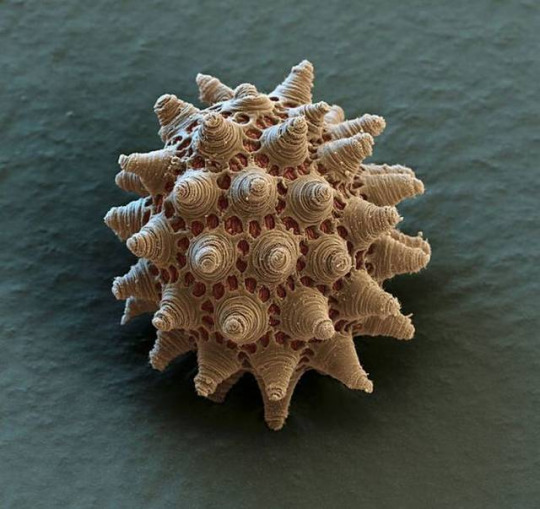
(Image: an electron microscope image of a tardigrade egg. It is round but covered in small pores and conical structures. End ID)
The most famous feature of tardigrades is their legendary durability. It is commonly said that tardigrades can survive just about anything (except for the things that are actually trying to kill them. They are prey to a lot of species after all). Among the things they can survive is extreme heat, extreme cold, dehydration, extremely high and low pressure, exposure to ionizing radiation (that's the scary kind), low oxygen environments, environmental toxins, heavy impacts, and the vacuum of fucking space. While the can survive in extreme conditions, tardigrades are not considered extremophiles. True extremophiles thrive in extreme environments and are negatively impacted by leaving them. Tardigrades can survive in extreme environments, but are negatively impacted and can't survive as well there as they can in less extreme places. The main trait that has allowed tardigrades to survive all five mass extinctions in history is cryptobiosis. Cryptobiosis is the rare ability for an animal to enter a state of dormancy where their metabolic processes come to an almost complete stop. While in cryptobiosis, metabolic activity drops to 0.01% normal and water content drops to 1% normal. In this state, the tardigrade is called a tun. Tardigrades usually enter cryptobiosis in response to arid conditions. One experiment showed that a species of tardigrade could last for at least 30 years in this state and return to normal lifestyle functions when exposed to water. Tardigrades will also enter cryptobiosis in response to low oxygen, toxic chemical exposure, increased or decreased temperature, and excessive salt content in the water. Tardigrades also show extreme resistance to both high and low pressure. They can live in 0 atmospheres of pressure and some species can survive up to 6,000 atmospheres, more than double the pressure at the bottom of the Marianas trench. More interesting is their ability to survive dangerous radiation. They can survive 1,000 times the dose of gamma radiation that humans can. Early tests focused on tardigrades in cryptobiosis and concluded that the extremely low water content of a cryptobiotic tardigrade doesn't leave much opportunity for the radiation to react with the animal. However it was later found that active and fully hydrated tardigrades are still considerably resistant to radiation. Studies into this resistance indicate that tardigrades can very efficiently repair damaged DNA and have unique proteins called Dsup that provides additional protection. Dsup introduced to human cells has provided additional protection against x-rays.
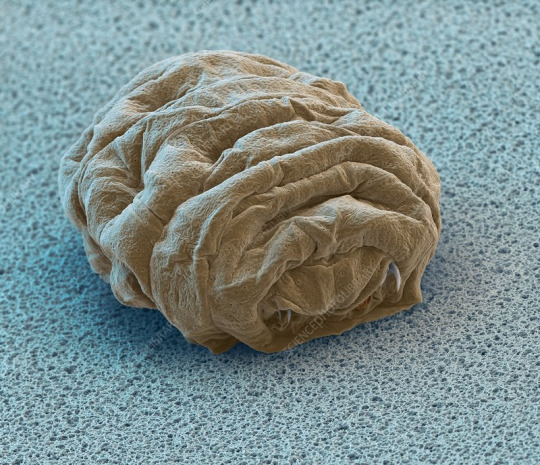
(Image: an electron microscope image of a tun - a tardigrade in cryptobiosis. It is smaller and very wrinkly, with the legs and mouth retracted into the body. End ID)
Tardigrades were the first animals to be exposed to the vacuum of space. They were exposed for 10 days, some in a state of cryptobiosis at the time of exposure and some still active. It was found that they were able to survive the vacuum when shielded from the sun's ultraviolet radiation, with those already in cryptobiosis doing better. Upon being rehydrated, many were able to resume normal life functions and successfully reproduce, though others died after being rehydrated. Those that were exposed to UV radiation fared much worse, with only a few hydrated individuals surviving. The individuals in cryptobiosis had a lower survival rate when exposed to UV than those not exposed to UV and were less successful at reproducing afterwards. Studies of tardigrade's space survival abilities and resistance to radiation could go a long way in helping human space travel. One of the largest dangers of space travel is that space is full of nasty radiation from the sun that Earth's magnetic field protects us from. Some scientists speculate about the possibility of accidentally seeding other planets or moons with tardigrades or other space-resistant organisms. This is a problem because introducing Earth life to other world has the potential to damage any native ecosystems and if we find life in space in the future we don't want to have to figure out if it's something we accidentally put there. While tardigrades could likely survive on other planets, they would eventually die without a food source. Some sources reported that tardigrades may have colonized the moon after an experiment with them crashed. Unfortunately, the moon is not crawling with tardigrades now. It's way too dry for them to exit cryptobiosis even if they survived the crash, which they probably didn't.

(Image: art of a tardigrade floating in the vacuum of space. End ID. Source: University of California - Santa Barbara)
#wet beast wednesday#tardigrade#water bear#moss piglet#micro animal#microbiology#marine biology#biology#zoology#ecology#animal facts#informative#science#space#astrobiology#radiation#cryptobiosis#tun#image described
202 notes
·
View notes
Text
How Andor (sort of) ruins Mon Mothma
I am less happy with what Andor did with Mon Mothma than many. I enjoyed her in Season 1, and if Season 2 had brought her story more in line with what we hear second hand about the Rebellion in the OT (and what we see in Rogue One), I would have been happy. The following is a long(ish) explanation for why I am not.
Part One: How to overthrow a government
Some patterns around rebellions can be generalized to allow for a simplified model on how they can succeed. I got the following from this video: The Insurgent Lifecycle. There are several phases.
Legitimate Grievance: A group of people has a grievance that politics could address but doesn't.
Political Action Committee: Some people from this group organize to try to get the political leadership to address this grievance. They try to go through legal channels.
Activism: When politicians fail to respond, the PAC goes to the public instead. It tries to drum up support to put pressure on the politicians. Spontaneuos violence is possible at this stage, but not a deliberate strategy.
Insurgency: The government cracks down on activism, so the movement turns to illegal means. This can go from property damage all the way up to terrorism. Insurgencies however are incapable of overthrowing the government because the balance of power heavily favors the government. The have some hope that the government will consider the cost higher than the benefit and make some concessions. But if it doesn't, the insurgency will need to have to turn itself into a guerilla force.
Guerilla war: For this, the rebellion needs a place it can withdraw to, where it will be save from attacks by the government. Difficult terrain like mountains or jungle are possible, but better is another country which border the governments forces are unwilling to cross. Guerrilla movements need to be able to do real damage to government forces and for that they need help. So they often depend on foreign governments to give them arms, supplies, and military advisers. But this cannot be the final step, because the balance of power still favors the government. Concentrated force will crush the guerrilla force, which is why they need a safe place to withdraw to.
Conventional war: What the rebellion actually wants is to become a conventional military that can defeat the government's forces, hold territory and eventually take the capital and become the legitimate government itself. (Or, if it is an independence war, force the government into a treaty that grants independence.) For that it needs to approach the capabilities of a conventional military.
There are two points where this chain is especially vulnerable to be interrupted. One is in the activist phase. If the movement is unsuccessful in the activist phase, people might decide to give up. They may be unwilling to risk their life for the cause (or to kill for it), so they decide to go home. The other is in the insurgency and guerrilla phase. If the movement cannot gain supplies through supporters, it may turn more and more towards crime, like robbery, extortion, and drug smuggling. Over time an unsupported insurgency or guerrilla force may become little more than a gang. So in this phase the movement has a ticking clock to either grow or fail. It needs large scale support.
Part Two: The insurgent lifecycle in Star Wars
Star Wars doesn't follow the outlined steps to the letter (in the real world each successful revolution also has its own quirks too), but we can roughly place different scenes along the it.
Original Trilogy
The Original Trilogy shows the Rebel Alliance in the guerrilla phase. The title crawl of the first movie says it, the Rebels attack from a hidden base, but have managed to win their first battle against the Empire. In Return of the Jedi Mon Mothma says that the Imperial Fleet is "spread out throughout the Galaxy in a vain effort to engage [the Rebels]". The Emperor's trap in that movie was an attempt to lure the Rebel fleet into a conventional battle where it could be destroyed - a miscalculation and the Rebels show themselves capable of winning that battle. I said above that guerrilla forces need support to challenge the governments forces, support that is difficult to get without friendly states supplying you. But in Star Wars, the Galactic Empire rules the entire galaxy, so there cannot be support on on that level, can there? Actually, yes there can be, if one pays careful attention to the dialogue.
The crucial scene is the one in the conference room on the Death Star. Here we learn several important bits of information:
The Rebellion is well equipped.
The Rebellion has a growing support in the Imperial Senate.
Before the Death Star the Empire needed the Senate to control the local systems.
The Death Star induced fear of planetary destruction will (so at least Tarkin's plan) make the local systems obedient to Imperial sector governors.
If we read between the line, reasonable conclusions from this are:
The Empire doesn't have enough manpower for direct control of the local systems (so it tries to solve this problem with superior firepower).
There are local systems that are semi-openly funneling military equipment to the Rebellion. (Alderaan seems to be a well known supporter of the Rebellion, but there are others. Tarkin wanted to demonstrate the Death Stars power on a high profile Rebel world, trying to get Leia to talk merely determined which world it would be.)
So the supporters of the Rebel Alliance at this point seem to be not only individual, but the governments of entire planets.
Prequels and Rogue One
In the deleted scenes of Revenge of the Sith we see the Rebellion in its infancy as a Political Action Committee. Bail Organa, Mon Mothma, and other senators (The Delegation of 2000) give a formal petition to the Palpatine where they object to establishment of sector governors. This also gives insight into what the legitimate grievance that forms the base of the Rebellion is: local autonomy, meaning the traditional rights of local systems within the broader framework of the Galactic Republic.
Rogue One adds some interesting nuances:
The Rebellion on Yavin at the point of Rogue One doesn't seem to be in a state of open war against the Empire yet. (Mon Mothma says she thinks open war is "inevitable", meaning it hasn't started.)
Mon Mothma tells Jyn that she wants Galen to testify about the Death Star before the Senate. Vader tells Krennic that the Senate has been informed Jedha was destroyed by a mining accident. The Senate seems at least in theory to be capable of taking action against Palpatine.
Five senators are part of the ruling council of the Rebellion (together with some generals/admirals). The council seems to work on a consensus base.
Learning about the Death Star leads some of these senators to advocate surrender to the Empire.
Here is how I interpret the general political situation from these facts: There is a growing group of senators that wants to remove Palpatine from power and restore the Republic. Legally it is within the Senate's power to do that, after all, they gave Palpatine these powers in the first place. They expect however that Palpatine might not accept this, so they have been building a military at secret locations in parallel to their political efforts. The Rebellion has ties to various local insurgencies (like the one of Saw Gerrera), but is not identical with them. So we have a top-down PAC with ties to bottom-up insurgencies, with the PAC preparing to transition to a guerrilla force when necessary. The Imperial leadership knows this and has for years been working on the Death Star to get the upper hand. In the end, it is not action in the Senate that marks the beginning of open warfare, but the Rebel attack on Scarif, which happens against the decision of the Alliance's ruling council. Rogue One starts it and Mon Mothma, Bail Organa, and Admiral Raddus decide to support the attack without the others' approval (instead of denouncing at as, well, rogue). My headcanon is actually that when the Emperor dissolved the Senate soon after, the attack on Scarif was the pretext.
I should also note that Rogue One presents Mon Mothma as the leader of the Rebel Alliance already at this stage (not a role she grows into after Bail's death).
Part Three: Andor Season 1 already has problems with Mon Mothma, but it mostly works
Andor presents two parts of the Rebellion in two different phases. Ferrix shows activism turning to violence. Meanwhile Luthen is building a network of various insurgencies, getting them funding, and organizing the theft of Imperial military equipment. Cassian's story connects both plotlines and adds his personal journey of radicalization.
Okay, so what does Mon Mothma do? Her scene with Tay Kolma gives insight into how Andor interprets her. I couldn't find a video of the entire scene, this one is the best I can do. So in Andor Season 1 she says her work in the Senate is a front. What she is really doing is raising money. That money, as we learn in other scenes, is going to Luthen, who forwards it to various insurgent cells.
Good scenes, but I have a problem with them. What's the problem? The problem is that in the long run this approach doesn't scale. Local insurgencies may irritate the Empire, but to overthrow it you need an full on military. And a military cannot be financed from Mon Mothma's personal accounts. Nor can she or Luthen buy them large numbers of X-Wings and U-Wings and Corellian Corvettes and Mon Calamari Cruisers under the table. No, for the Rebellion to have a shot at winning, it will need to become much larger.
What the Rebellion needs is coalition building. What the Rebellion needs is entire systems supporting it, not just wealthy individuals. Who could build such a coalition? Not Luthen, he is building a spy network. No, it would be someone like Mon Mothma.
Season 1 is not about that. Her storyline is about crossing moral lines for the Rebellion (framing her husband to hide the money she gave the Rebellion, starting her daughter on the arranged marriage path).
Well, perhaps this will come later.
Part Four: Andor doesn't show how to fight fascism
Unfortunately it doesn't. Mon Mothma has two important events in Season 2: Letting Luthen kill Tay Kolma and denouncing the Ghorman massacre. Somehow there is a coalition in the Senate that builds an army on Yavin, Mon Mothma and Bail Organa are part of it. They even discussed what to do when the Empire commits a large scale atrocity. But the important work of bringing that coalition together happens offscreen. Convincing local planetary governments to supply Yavin happens offscreen. Yavin is built largely offscreen. The Alliance's ruling council is brought together offscreen. Basically the entire transition of the Rebellion from a network of insurgencies to a guerrilla force capable of inflicting real damage on the Empire happens offscreen.
Because of this, there is a gaping hole in Andor if we take it as a manual on how to fight fascism. And I very much think it is supposed to be that. The series was conceived during the first Trump term and many elements of Season 1 are taken from leftist theory. The series shows personal radicalization with Cassian, communities turning to violence as a form of resistance with Ferrix, the building and running of underground organizations with Luthen and how they are funded. Season 2 explores the role of narrative, with regime and rebellion both trying to take control of it.
The coalition building is missing. In Season 1 we don't see how Luthen convinces the different insurgences (who hate each other) to work together, and in Season 2 we don't see Bail and Mon convincing senators and planetary governments to build a military together. But to defeat an authoritarian government that is necessary. (There are three ways an authoritarian system can fall: Either the government loses faith in itself and steps down, or the military loses faith in the government and steps aside when the people are in the streets, or someone brings an army large enough to challenge the military. Star Wars, and with it Andor, shows option three, so if Andor wants to be a serious exploration on how this can be done, it would need to show how get people together who can build such an military.)
Part Five: Why Andor cannot show how to build a coalition against fascism
Now here is my provocative thesis: Andor cannot show how to build a coalition against fascism because the leftist theory it is based on, together with widespread cynicism about politics, has undermined the hope that good government is possible. Government is power and much of modern leftist theory thinks all power is oppression. Therefore being the government is inevitably immoral.
But an alliance that is aiming to overthrow a government is aiming at becoming a government. It needs an idea for what it wants the world to look like. And Andor is silent on that. Luthen talks about the "sunrise he will never see". Nemik's manifesto says one act of resistance will eventually "break the siege". But I don't think at any point in the series does anyone talk about something specific, like restoring the Republic, which is in the Rebel Alliance's official name. There are hints at what some of the various insurgencies that Luthen connected want (and that they don't agree on their goals), but they are mostly mentioned so that Saw can dismiss them.
The Original Trilogy could afford to be vague about the political vision of the Alliance, but even in its vagueness I feel it had a clearer vision than Andor. It's allegiance was to democracy. To liberal democracy of the American variety. George Lucas wrote the Empire as a dark reflection of the United States where the authoritarian tendencies he observed (during the Vietnam war, for example) won out. The positive vision was a republic in which these authoritarian tendencies were defeated (and where spirituality played a larger role - a story for a different time). But this vision has lost its power for many and none of the alternatives seems to be widely convincing.
In the Original Trilogy it is implied that Mon Mothma's political vision (shared with others like Leia) can bring together a coalition large enough to challenge the Empire. In Andor, which goes more into detail on politics, this implicit vision would need to have been made explicit. But the showrunners cannot do that, so they present a lesser (but still powerful) version of Mon Mothma to tell a story about sacrifice for the cause - even if it can tell very little about the cause except for that it includes the Empire's fall.
And that is why I think Andor ruined Mon Mothma (or rather falls way short of the potential Mon Mothma as a main character had to offer).
31 notes
·
View notes
Text
I fucking love boxworms and fire sprites
they might as well be the closest extant cousin of iterators
a photoplasmic brain with a steam producing body/nest, the similarities to overseers (and even neurons to an extent) is undeniable

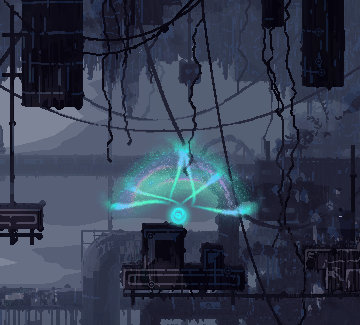

(thank you @iteratorsex for the overseer gif, all other gifs in this post are from the wiki)
you can see them gathering resources (dust (for food? definetively for growing the boxworm) and potentially water or at least hydrogen and oxygen) like a jellyfish or perhaps a sponge (the way it opens and closes its mouth is very cute too)
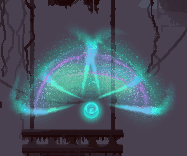
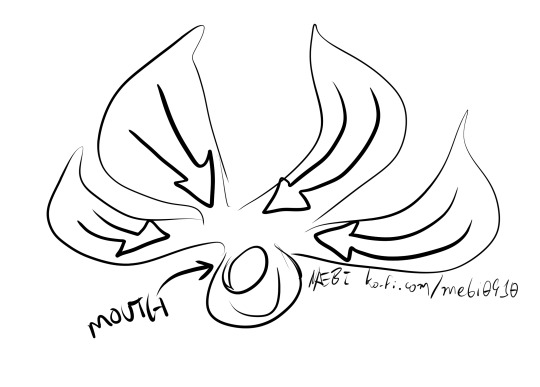
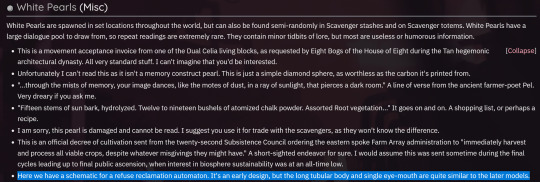
Here we have a schematic for a refuse reclamation automaton. It's an early design, but the long tubular body and single eye-mouth are quite similar to the later models.
mmm, interesting
btw the way the tendrils unfurl into conveyor fans here remind me of a theory ive had that overseers deploy a thin membrane in order to project holograms to
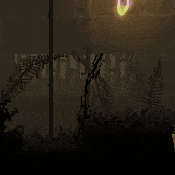
the boxworm is a body actioned through pneumatics and also a host for the eggs to grow in
the activation animation is very fun (are those glass windows in the box "eyes"?)
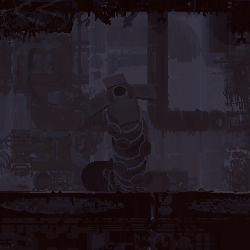
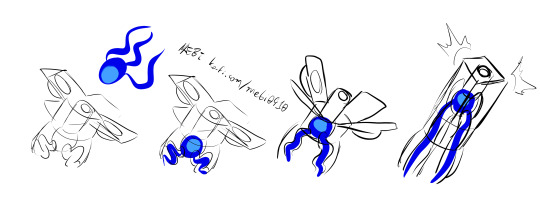
is the water gathered by the fire sprite? or is it created by combining hydrogen and oxygen? if the latter, would these gasses be collected or synthesized through organic processes? either way it serves the same function as hemolymph in spider legs, even if the shape is worm-like
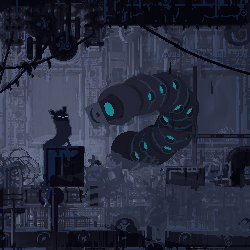

soft robotics comes to mind (here's another example)
talking about the eggs, i wonder what's the lifecycle like? do the fire sprites grow their own boxworm from zero? slowly from gathered dust? or is this an intestinal worm situation, and each boxworm segment eventually separates once its corresponding fire sprite matures?

now, the structure of the boxworm and the fire sprite larva situation has made me realize a possibility that would have me reconsider and in a way complete my iterator biota lifecycle theory:
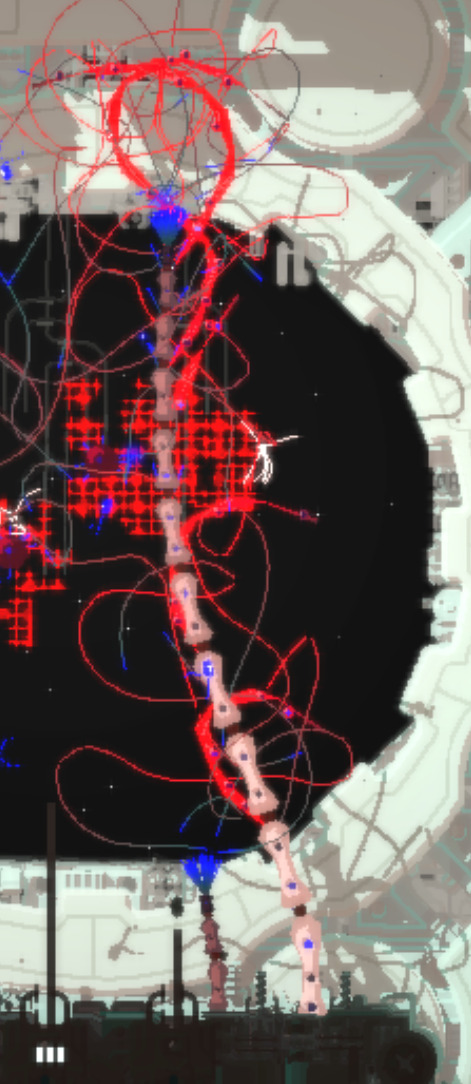
coral stems are segmented with little balls/openings, kinda like the boxworm in a way
while coral stems are bundles of mycelia and a number of small flashing cores sheathed on self-grown shells, it is possible neuronflies and overseers are grown from these flashing dots
after all, coral neurons already grow out of these stems
31 notes
·
View notes
Text
Environmental cost of electronics
This is a good article on the environmental cost of all those electronic devices we use. It covers manufacturing, use, and disposal, and then presents some suggestions to minimize the environmental impact of the electronics we use. A few suggestions to highlight:
Turn it off or unplug it when it’s not in use. Many of these devices draw small amounts of power even when they’re turned off.
Keep your devices a little longer and repair them instead of replacing them. When you replace them, buy the most energy efficient models or buy refurbished.
Before you buy a new electronic gadget, think about how much you are actually going to use it. Maybe you don’t need it after all.
When electronics are ready for disposal, take them to a reputable electronics disposal facility so that valuable materials can be recycled and toxic waste products can be appropriately managed.
11 notes
·
View notes
Text
My Role Model Emma Watson & Slow Fashion
Week 7: Social Media Influencers and the Slow Fashion

HELLO! Welcome back, friends!!! Today, I’d like to talk about slow fashion and how public figures, especially celebrities, influence this movement. Do you have any role models you look up to?
I’ve admired Emma Watson since I was a child, and after watching the Harry Potter series, she quickly became someone I deeply respected. In this post, I want to highlight one of the things I admire most about her which is her environmental activism, especially her strong commitment to slow fashion and creating a more sustainable future. 🌍✨


Firstly, what is slow fashion? Slow fashion is a movement within the fashion industry that promotes environmentally friendly and ethical choices, including ethical sourcing, the use of recycled and organic materials, durable high-quality products, timeless styles, respect for craftsmanship, and fair wages and protection for workers (Brewer, 2019). This concept draws inspiration from the “slow food” movement, which emphasizes responsibility in the production and consumption of food. Influencers and celebrities have made this movement visible and its values are spreading through digital spaces.
The fashion industry is recognized as one of the most environmentally damaging industries at every stage of its lifecycle. Fast fashion brands such as Zara and H&M, which continuously release imitation designs at minimal cost rather than adopting slow fashion principles, dominate the current fashion industry. According to Domingos et al. (2022), until about 20 years ago, only two collections (spring/summer and fall/winter) were produced annually. However, with the acceleration of trend cycles, 50 to 100 mini-collections are now released into the market each year.

As I mentioned earlier, the slow fashion movement has been gaining momentum in recent years and has drawn increasing attention from the public. Influencers and celebrities play a significant role in promoting sustainable and slow fashion and distributing its message. One of the most iconic figures in this movement is actress and activist Emma Watson, whom I briefly mentioned at the beginning of this blog. She has long been ahead of her time, championing vintage fashion before it became mainstream, and consistently appearing in eco-conscious and ethical looks on the red carpet (Chan, 2023). For instance, as shown in the image above, she wore a Calvin Klein dress made from recycled PET bottles to the 2016 Met Gala, an example of her active support for sustainable slow fashion. Moreover, she launched an Instagram account called @the_press_tour to raise awareness about sustainability. On this platform, she shares photos of her sustainable outfits worn at public events with captions that advocate the slow fashion movement and explain how vintage and slow fashion contribute to environmental protection. She also features brands that are committed to ethical and sustainable practices.
Of course, many other influencers and celebrities support and advocate for the slow fashion movement. However, I chose to focus on Emma Watson in this article because she not only supports slow fashion, but she is also my role model in my life and someone I relate to.

She does more than just wear sustainable clothing, she has created a dedicated Instagram account to raise awareness about environmentally conscious practices and actively promotes sustainability. For this reason, she is a suitable figure to discuss in the context of this theme. She not only supports her beliefs but also takes action to advocate for the public. Her sustainable mindset has actually influenced my way of thinking. To be more specific, since I started following the content she shares, I have become more mindful of the materials, durability, and production locations of the clothes I purchase. Instead of simply choosing inexpensive, trendy designs, I now make an effort to choose and purchase more sustainable options.
I hope that more people, like me, will be inspired by someone they admire and adopt a more environmentally conscious way of thinking, which will benefit the Earth and future generations. 🌍🌟
References:
Brewer, M. K. (2019). Slow Fashion in a Fast Fashion World: Promoting Sustainability and Responsibility. Laws, 8(4), 24. https://doi.org/10.3390/laws8040024
Chan, E. (2023, December 14). 13 of Emma Watson’s best sustainable looks to date. British Vogue. https://www.vogue.co.uk/fashion/gallery/emma-watson-sustainable-fashion
Domingos, M., Vale, V. T., & Faria, S. (2022). Slow Fashion Consumer Behavior: A Literature Review. Sustainability, 14(5), 2860. https://doi.org/10.3390/su14052860
9 notes
·
View notes
Text
Cost vs. Quality: What to Consider When Investing in Switchgear

In today’s energy-intensive world, switchgear plays a critical role in managing power distribution safely and efficiently. Whether you’re upgrading your industrial facility, building a commercial plant, or powering a large infrastructure project, choosing the right switchgear is not just a technical decision — it’s a strategic investment. One of the most common dilemmas buyers face is balancing cost vs. quality. So, how do you decide?
Understanding Switchgear: The Heart of Electrical Safety
Switchgear is a combination of electrical disconnect switches, fuses, or circuit breakers used to control, protect, and isolate electrical equipment. Its primary role is to ensure the reliability and safety of your power system.
Types of switchgear include:
· Low-voltage switchgear (for commercial and residential use)
· Medium-voltage switchgear (typically for industrial applications)
· High-voltage switchgear (used in power transmission)
Investing in the right switchgear directly impacts operational continuity, personnel safety, and overall infrastructure reliability.
The True Cost of Cheap Switchgear:
While it’s tempting to opt for budget-friendly solutions, low-cost switchgear often comes with hidden risks and long-term expenses.
Inferior Material Quality
Cheaper models often use substandard materials that degrade faster, leading to frequent maintenance or early replacement.
Safety Hazards
Low-quality switchgear can result in arc faults, insulation failure, or overheating — putting workers and equipment at risk.
Increased Lifecycle Costs
Although the initial price may be low, the total cost of ownership (including downtime, repair, and energy inefficiency) is usually higher.
Limited Scalability and Customization
Budget systems are often rigid and harder to scale as your facility grows or needs change.
Why Quality Switchgear Pays Off
When you invest in premium switchgear, you’re not just buying a product — you’re buying peace of mind.
Enhanced Reliability
High-quality switchgear is engineered to perform in extreme conditions and handle high fault levels without compromising performance.
Superior Safety Standards
Reputable brands comply with international standards such as IEC, ANSI, or UL, reducing liability and improving workplace safety.
Ease of Maintenance
Well-built switchgear is modular and user-friendly, simplifying diagnostics and minimizing downtime during maintenance.
Energy Efficiency & Smart Capabilities
Modern switchgear includes IoT sensors, real-time monitoring, and predictive maintenance features, ensuring optimal energy use and proactive problem resolution.
Key Factors to Consider When Choosing Switchgear
When evaluating switchgear options, balance cost and quality by focusing on the following:
1. Application Requirements
Understand your voltage class, load types, and fault current ratings. Quality should match your operational demands.
2. Brand Reputation & Certification
Look for trusted brands with certifications like ISO 9001, CE, or IEC 62271. Positive reviews and case studies add credibility.
3. Lifecycle Costs
Don’t just compare sticker prices — consider maintenance, service availability, spare part costs, and expected lifespan.
4. Customization & Flexibility
Choose systems that can evolve with your operation. Modular designs support upgrades and expansions more efficiently.
5. Support and Service
Ensure the manufacturer provides robust after-sales support, technical training, and warranty services.
Cost vs. Quality: The Bottom Line
When it comes to switchgear, cheap is rarely cheerful. Cutting corners today can lead to outages, hazards, and hefty repair bills tomorrow. On the other hand, investing in high-quality switchgear ensures operational resilience, safety, and long-term savings.
The smartest strategy? Aim for value, not just price. Evaluate switchgear as a long-term asset, not just a one-time purchase.
Trending Tip: Think Smart and Sustainable
With rising energy demands and climate-conscious regulations, smart and sustainable switchgear is trending. Look for:
· Eco-friendly insulation (like SF₆-free switchgear)
· Energy management features
· Digital monitoring systems
Investing in such features not only future-proofs your infrastructure but can also help you qualify for green certifications and incentives.
Final Thoughts
Balancing cost and quality in switchgear selection is about understanding your long-term operational goals. By focusing on durability, safety, and lifecycle value, you can make a decision that protects both your budget and your business.
8 notes
·
View notes
Text
Bridging Smart City Visions and Budgets with a Construction Cost Estimating Service
As cities worldwide shift toward smarter, more sustainable development, the idea of a "smart city" has moved from aspiration to implementation. These urban environments are designed to leverage data, technology, and intelligent infrastructure to improve livability and efficiency. However, turning smart city concepts into real, functional spaces requires more than innovation—it requires precise financial planning. A construction cost estimating service plays a critical role in aligning bold urban visions with practical, achievable budgets.
Understanding the Smart City Framework
Smart cities are built on interconnected systems that include digital infrastructure, energy-efficient buildings, intelligent transportation, and real-time public services. Examples include sensor-based lighting, integrated data platforms, automated waste management, and green infrastructure.
Each element has financial implications, from high-tech installations to long-term maintenance. Cost estimating services help translate these visionary features into actionable plans by forecasting expenses across the project lifecycle.
Challenges of Budgeting for Smart Cities
Smart city projects pose several budgeting challenges:
Technology evolution: Rapid innovation can make systems obsolete mid-project.
Cross-sector integration: Combining infrastructure, software, and construction raises cost complexity.
Data infrastructure: Building digital backbones adds another layer of cost beyond traditional construction.
Long-term sustainability goals: Energy systems and green design often involve higher initial investment.
These challenges make it essential to include experienced cost estimators early in the planning process to anticipate and manage financial complexity.
Benefits of a Construction Cost Estimating Service in Smart City Projects
Translating Vision into Numbers
Convert abstract smart city features into quantifiable line items.
Include software, hardware, and systems integration costs.
Map budgets to both current needs and future scalability.
Balancing Innovation with Cost
Assess value versus cost for smart features like IoT devices or automated systems.
Identify areas where innovation yields the highest return.
Prevent overinvestment in tech that doesn't improve efficiency or performance.
Integrating Infrastructure and Digital Layers
Estimate costs for physical and digital components together.
Include broadband, sensor networks, and control centers in construction budgets.
Forecast long-term operational costs such as data storage, upgrades, and monitoring.
Scenario Modeling for Smart Alternatives
Compare options like smart HVAC vs. conventional systems.
Evaluate solar energy integration versus grid reliance.
Analyze smart parking systems against traditional parking infrastructure.
Creating Adaptable Budgets
Smart cities evolve constantly. What’s innovative today may need updating tomorrow. A construction cost estimating service develops flexible budgets that adapt to:
Phased implementations
Future technology upgrades
Changing regulations or codes
Shifting funding sources
This adaptive budgeting ensures that smart city initiatives stay on course—even in a changing environment.
Collaborating Across Stakeholders
Smart city developments involve a mix of partners:
Government agencies
Private tech firms
Utility companies
Community stakeholders
Cost estimators provide a unified financial picture that all stakeholders can understand. This helps build consensus and trust, especially when projects are funded by public-private partnerships.
Risk Management in Smart Infrastructure
The technical complexity of smart cities increases financial risk. A single system failure could disrupt multiple services. Cost estimators manage these risks by:
Including redundancy costs for critical systems
Building in cybersecurity considerations
Accounting for maintenance, system support, and service contracts
This forward-thinking approach supports not just the build-out of smart infrastructure, but its sustainable performance.
Cost Planning for Sustainable Smart Design
Sustainability is a pillar of smart cities, encompassing:
Energy-efficient building design
Renewable energy integration
Low-impact materials and construction
Green transportation systems
Estimating services align sustainability goals with realistic budgets by:
Forecasting ROI for sustainable features
Incorporating incentives, rebates, and tax credits
Calculating lifecycle cost savings versus upfront spending
Linking Digital Twin Technology with Budget Planning
An emerging tool in smart cities is the "digital twin"—a real-time virtual model of the physical city. These systems help manage infrastructure more efficiently but come at a significant cost.
Cost estimators help:
Quantify the setup and operational cost of digital twins
Align them with existing construction and infrastructure budgets
Model upgrade paths and maintenance needs
This integration ensures the technology’s benefits are achieved without undermining financial feasibility.
Planning for Scalability and Future Growth
Smart cities are designed to grow. Estimators help projects prepare for future demands by:
Including scalable systems in original budgets
Creating allowances for future construction phases
Modeling per-capita infrastructure costs based on projected growth
This long-term outlook prevents underinvestment and supports urban resilience.
Conclusion
Smart cities represent the future of urban living—data-driven, energy-efficient, and responsive to the needs of their populations. But without detailed financial planning, these projects risk becoming too expensive, overly complex, or disconnected from reality.
A construction cost estimating service brings structure and clarity to the process. By accurately forecasting the cost of innovation, integration, and long-term performance, it enables urban planners, engineers, and policymakers to turn smart city concepts into budget-aligned action. In a world where cities must be both intelligent and sustainable, the foundation of success begins with smart estimating.
#smart city#cost estimating#budgeting#urban planning#digital infrastructure#IoT construction#energy efficiency#green building#public-private#lifecycle cost#sustainable urbanism#infrastructure cost#data networks#smart HVAC#digital twins#city design#modular systems#cost forecasting#stakeholder alignment#smart mobility#green infrastructure#urban innovation#adaptive budgets#risk management#maintenance cost#cost modeling#urban resilience#construction pricing#funding strategies#scalable systems
0 notes
Text

BIM Process & Lifecycle In Building Construction
Building Information Modeling encompasses the entire process of planning, designing, constructing, operating, and maintaining a building or infrastructure project using a digital representation.
3D Planning and Design
Building Information Modeling (BIM) begins with the creation of a detailed 3D model that includes architectural, structural, and MEP (Mechanical, Electrical, Plumbing) components. This phase allows for visualization, analysis, and optimization of the design before construction begins.
Operation and Maintenance
After construction, the BIM model serves as a valuable resource for managing the building throughout its lifecycle. Facility managers use the model for maintenance, repairs, and renovations, ensuring the building operates efficiently.
Project Collaboration
BIM facilitates seamless collaboration among all stakeholders, including architects, engineers, contractors, and owners. The shared model ensures everyone is on the same page, reducing errors and improving communication.
Construction
During construction, the BIM model guides the building process, providing detailed information on materials, timelines, and workflows. This enhances accuracy, reduces waste, and ensures the project stays on schedule and within budget.
By integrating these stages, BIM enhances collaboration, reduces costs, and improves the overall quality and sustainability of construction projects.
0 notes
Text
Public comment on AI Exc. Order closes @ end of day 15 March 2025
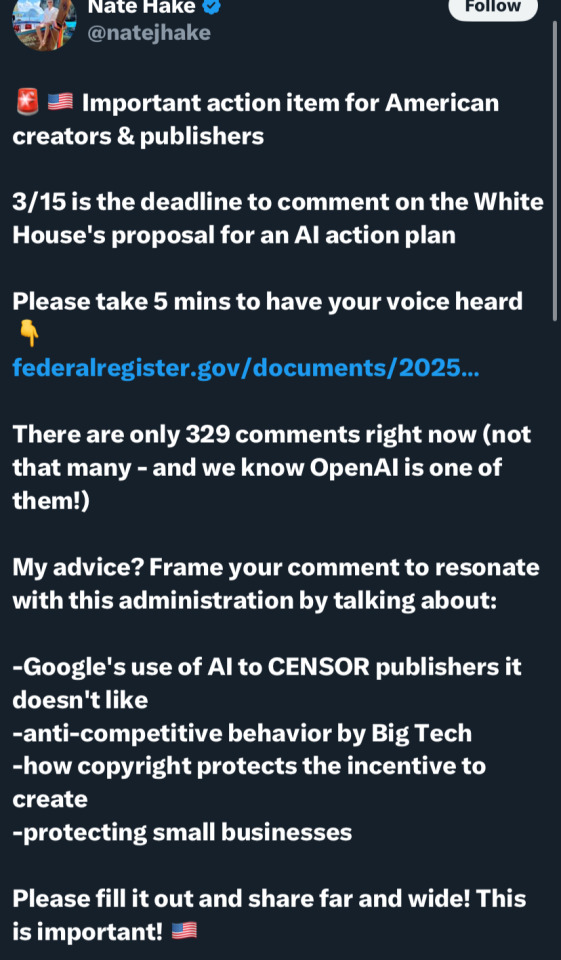
SUPPLEMENTARY INFORMATION:
On January 23, 2025, President Trump signed Executive Order 14179 (Removing Barriers to American Leadership in Artificial Intelligence) to establish U.S. policy for sustaining and enhancing America's AI dominance in order to promote human flourishing, economic competitiveness, and national security. This Order directs the development of an AI Action Plan to advance America's AI leadership, in a process led by the Assistant to the President for Science and Technology, the White House AI and Crypto Czar, and the National Security Advisor.
This Order follows the President's January 20, 2025, Executive Order 14148, revocation of the Biden-Harris AI Executive Order 14110 of October 30, 2023 (Safe, Secure, and Trustworthy Development and Use of Artificial Intelligence), which hampered the private sector's ability to innovate in AI by imposing burdensome government requirements restricting private sector AI development and deployment. The Trump Administration recognizes that with the right government policies, the United States can solidify its position as the leader in AI and secure a brighter future for all Americans.
OSTP seeks input on the highest priority policy actions that should be in the new AI Action Plan. Responses can address any relevant AI policy topic, including but not limited to: hardware and chips, data centers, energy consumption and efficiency, model development, open source development, application and use (either in the private sector or by government), explainability and assurance of AI model outputs, cybersecurity, data privacy and security throughout the lifecycle of AI system development and deployment (to include security against AI model attacks), risks, regulation and governance, technical and safety standards, national security and defense, research and development, education and workforce, innovation and competition, intellectual property, procurement, international collaboration, and export controls. Respondents are encouraged to suggest concrete AI policy actions needed to address the topics raised.
Comments received will be taken into consideration in the development of the AI Action Plan.
6 notes
·
View notes
Text
I’m just venting and sharing my personal thoughts. I’m normally a very happy person, but right now I’m so mad. I’m permitted to do activities for science, and the teacher said I’m only allowed to do one art based activity for the entire year? But what if my brain works artistically? I tried to dance around this by making a physical model of a flower and showing how it works on the inside and then doing a separate activity where I drew a mushroom’s lifecycle and wrote a little paper on it. Those are obviously different projects that I put effort into and learned from.
I got points taken off both projects because they included art. What the heck? Why does school hate art? How do I even do a project without art? I’m so confused. Do I just write a paper? I get belittled for doing the things I find enjoyment in. “Don’t draw on your paper. You’re not listening”, “I’ll take points off if you do art.”
There was this time when I was in 4th grade and I doodled on my test while I was thinking about how to answer a problem. The teacher started YELLING AT ME. She took my test, and told all of the kids to start listening class and to never draw in class. Then she erased my doodle and sent me to the counselors office because I was crying. Long story short, this teacher had created lots of problems for a lot of other kids and she ended up getting fired later on.
But my point still stands. Art is important? Hello? What if we belittled mathematicians for doing math problems and yelled at scientists for doing experiments? Science brained people have such a clear path to college and so many opritunities. Artistic people have to blaze their own path while everyone’s telling them they’re gonna fail.
Let’s talk about this
Movies would be so dumb without music. Movies are important in culture! Video games are all about art and music. Video games are a big form of entertainment. Life without art is not a life at all. Look outside? THE ENTIRE UNIVERSE IS ART. The trees, the sun, the grass, wow! Yeah you can explain the beauty of earth with science, but I feel like we keep ignoring the clear companion to science which is art.
Why are creative people being attacked by AI and pushed down by society?
I know this sweet woman who is so skilled at art. She was told she wasn’t gonna make it financially, so she switched her major to engineering. She is so depressed with life. And she doesn’t have the confidence to go back to school and look into an animation job. What if rocket scientists were belittled and told to go become painters? What the heck?
This is so wrong. You know what else is wrong? Art class! In most schools, there’s only one art class! And it’s an elective, not a core class! As if they’re suggesting that art and music is optional and a lesser skill. 😡 In an age where movies and media are such a big part of society… don’t you think the arts are— idk, valuable?
My dad had a best friend who sucked at school because he thought strictly artistically. He was an amazing creator with a HUGE imagination! He was told that he was stupid and dumb because he couldn’t do math, and he failed multiple grades— but he was the greatest artist I have ever seen. He is no longer with us because he took his own life due to feeling like a failure. 💔
Don’t get me wrong, math and science is beautiful and extremely valuable! But I just wish that schools would acknowledge the beauty in the arts too. Life without art would be the most depressing place on earth. No murals, paintings, doodles, orchestras, ballads, visuals, concept art, video game characters, etc. Art is good for the mental health, why is it that so many people are struggling with mental health nowadays? It could be that the world is telling people to suppress their creative side. ❤️
My two cents. If you’re a science and math brained person, that’s totally okay and I love you! 💕 One of my best friends is obsessed with neurology and I hold her in a high degree of respect. My brother wants to become a surgeon, and my Dad is a doctor. Science is extremely important! This is not a hate post on right brained people ❤️❤️❤️ I’m just frustrated at how artists are often treated.
5 notes
·
View notes
Text
I'm actually pretty happy that Apple decided to put Severance out on weekly episode releases. Streaming already suffers from the shortened seasons, so dumping them all at once would make the season's entire lifecycle over in a weekend. Following the network model of episode distribution lets viewers build anticipation for whats coming next.
6 notes
·
View notes
Text

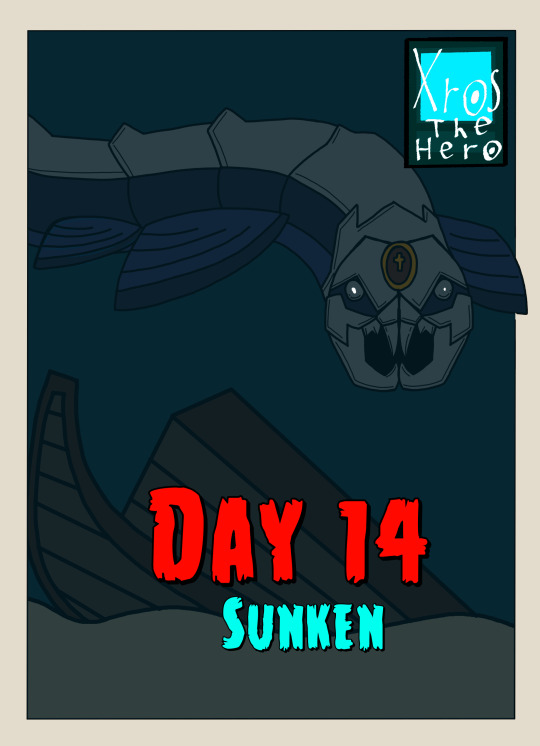
So yesterday I spent 12 hours non stop in a modeling software and decided that I deserved a little break, so today your getting 2 Kaijunes!
Day 13 and 14 of Kaijune!, Lifecycle and Sunken, Both are kind of rushed, but consistency is the most important thing too me right now, not making it look good
#kaijune#kaijune 2025#kaiju art#kaiju#kaijuneday13#kaijuneday14#art#digital art#monster#monster art#character design#crypt-x
3 notes
·
View notes